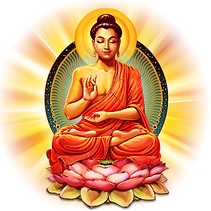Buddhism
- Megan Proctor

- Jan 31, 2023
- 2 min read
We have all heard about Gautama Buddha, but perhaps not all of us have heard about the origins of Buddha. The beginning of his path is what we know of as Buddhism today.
Prince Gautama Siddhartha ventured out of his palace for the first time

ever at the age of 29. His father feared that outside encounters would allow him to become ascetic, which is to renounce all material possessions and be devout to a life of pursuing spiritual goals. However, his first encounter outside of the palace moved him so deeply and made him realize the suffering of all and compelled him to become a wandering ascetic which eventually led him to his path of enlightenment.
After venturing out, Prince Siddhartha saw an old man, revealing to him the consequence of aging. He asks his charioteer, Channa, about the old man, to which he replies that aging happens to everyone.
The second sight was of a sick man suffering from a disease. When the prince asks about this, Channa replies that all beings suffer from disease and pain. This troubles the prince once more.
The third sight was a dead man's body. Channa again explains that death happens to everyone. After seeing these three sights, Prince Siddhartha was troubled and sorrowful about the suffering that life brings.
The fourth sight, an ascetic who devoted himself to finding the cause of all human suffering, gave him hope that he might also be released from the sufferings of repeated rebirth. From here, he denounces his own title as prince and leaves the palace, seeking a life of enlightenment.

The four sights, an old man, a sick man, a dead man, and a monk, were all sights that Buddha witnessed leading to the realization of impermanence and dissatisfaction of conditioned existence. This creates the 3 main concepts of Buddhism:
Interdependence: Everything in life is always changing. If one thing has changed to another, that thing has previously disappeared.
Impermanence: goes in hand with interdependence, as nothing is permanent and no desire is ever satisfied. You can be happy in one specific moment but the happiness is never permanent.
No-Self: This Buddhist idea is that there is no permanent, unchanging aspect of a person. Your "self" is permanent, but the consciousness and physical body are always changing. The atoms in your body are constantly changing, and your mind is always changing.
With these 3 main concepts, we find ourselves looking at the Four Noble Truths, which can be summarized by saying that all life is suffering, and the cause of suffering is attachment. You may never be satisfied, so to end your suffering, you must end your attachment and desire. To follow this, you must follow the Eightfold Path. This is a detailed description of the right ways to understand, live, meditate, speak, and much more. This is a true inspiration to many who seek to feel fulfilled with life as they are, and I would say reading into this more will help you find a deeper understanding of what you may be suffering within your own life and how to find true satisfaction.
Please see the links below I have provided if you are interested in further readings about Buddhism!

Comments